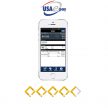
B2B Transactions: Level 2 & Level 3 Credit Card Processing
Being able to accept credit card payments is essential for business; this is especially true for B2B transactions. While checks and money transfers are an option, many companies prefer to pay by credit card due to the added security and the ease of payment. Card transactions also have benefits for the merchant too, as research shows that buyers who pay with credit card are willing to spend more, which can boost a company’s bottom-line, and help to improve cash flow.
However, one common concern among B2B merchants is the cost of the interchange fees: it can be far too easy for merchants to pay too much, but why is this? There are several reasons that can contribute to overpaying such as retailers not understanding the charges for interchange fees, but with B2B merchants there can be often be one precise reason why they end up paying more than they should: they aren’t set up for Level 2 or Level 3 credit card processing fees, which are cheaper.
By providing additional data with each corporate, business or purchasing card transaction they receive, a B2B merchant would qualify for Level 2 or Level 3 credit card processing fees, or Level II or Level 111 as they are also known.
Understanding Level 2 and Level 3 Interchange Rates
Before moving on to the specifics of Level 2 and Level 3 interchange rates, it is worthwhile explaining interchange rates in general.
Every business that takes payment by credit card or debit card pays interchange rates; these consist of a small percentage for each transaction made and a set fee. Major credit card companies like Visa and MasterCard set these fees and they are updated at six monthly intervals; the prices can go up or down.
These fees will vary depending on the nature of the transaction. However, there are also a variety of other factors that contribute to these fees, which is why some merchants can be unclear on exactly how much they are paying in interchange rates. Interchange fees are paid in the form of a Merchant Discount or a Merchant Service Fee, and they are all part of a retailer’s credit card/debit card processing fees; these fees go to the card issuer, not the payments processer.
Interchange rates are part of doing business, and necessary for having the ability to take credit card payments, however, B2B merchants could be saving a considerable amount on their credit card processing fees by qualifying for B2B interchange rates.
To qualify for the B2B interchange fees, merchants much provide a string of additional information to go with each transaction. Visa describes the data required for Level 2 and Level 3 data as enhanced data. The higher the level, the more the data the merchant must provide. As detailed below, there are three different levels of data:
Level 1 data is standard with all transactions and consists of basic information like the card number, start and expiry date data, the CVV2 code and zip code.
Levels 2 applies to corporate, commercial, government and B2B transactions, and requires all of the Level I data, and in Visa’s case they require the following information:
- Sales tax
- Sales Tax indicator
- A customer code
- Purchase ID
- Purchase ID format
Level 3 payments, which often include large transactions, require more detailed information, including summary data and line detail information. In Visa’s case the credit card company asks for:
- All the Level 1 and Level 2 data
- Destination country code
- Shipping/courier charges
- Discount details
- Date of order
- VAT information/reference number
- Country code destination
- And Zip code for delivery/sending
Level 3 line entry information required consists of:
- Level 1 and Level 2 data
- Commodity and product codes
- Unit cost/charge
- VAT details
- The units sold
- Quantity
- An item description
Master Card refers to this information as data rate; some of the information MasterCard asks for it slightly different. For instance, MasterCard request a tax amount to be given.
Submitting the additional information required to qualify for Level 2 or 3 interchange fees isn’t always easy for the retailer as most terminals don’t automatically prompt the merchant for the information, however, gathering the extra data doesn’t have to be quite as challenge as it might seem; if your provider offers B2B credit card processing, they’ll can pass this data for you.
Potential Savings When Submitting Level 2 and Level 3 Data
There is no obligation to submit this additional data, but depending on the volume of Level 2 and Level 3 transactions you take, it could save you at least one percent, while CardFellow.com estimates you could save up to 1.15 percent.
Here are some examples of how including Level 3 data could lead to reduced interchange fees:
The MC Corporate Rate I is set at 2.65 percent plus 0.10 cent fee. If a merchant submitted the Level 3 data, they would pay 1.75 percent plus a 0.10 cent fee for the transaction.
This is an example of the potential savings for Visa B2B merchants:
Visa’s purchasing card is charged at2.05 percent rate plus a 0.10 cent fee for its Level 2 data rate, while Purchasing Level III and Corporate Level III are set at 1.95 plus 0.10 cents.
Given the potential savings, why don’t more B2B submit this data? One common reason is that some merchants are using payment processors who don’t have the necessary experience in managing B2B credit card payments and their terminals are not set up to accept them. In addition, some payment processors don’t have the relevant expertise on accepting B2B transaction, which means B2B merchants often pay too much for card processing.
B2B Credit Card Transactions and the Cost to Business
As you’ll have seen from the examples in the above section, qualifying for Level 2 and 3 levels can result in noticeably lower fees for B2B merchants. If your business is in the B2B niche, supplying this data is certainly an option worth exploring if you want to increase your company’s profitability.
While these savings might seem small when looked at individually, the fees soon add up to a significant amount. In 2014, research from REL Consulting detailed the burden credit card fees were placing on business to business companies. Then, it was estimated that US-based B2B companies were paying an average of $2.2 million in credit card processing fees for every $1 billion of revenue.
Commenting on the research, REL Customer-to-Cash Practice Leader Veronica Wills, said:
“It’s not hard to understand why B2B customers have doubled their use of credit cards over the past few years, even for five and six figure payments.”
It’s an easy way to extend time to payment, and transaction processing cost to the purchaser is low. In addition, companies can often accrue rebates and rewards.
Ms Wills continued:
“…Visa, MasterCard and other credit card companies have tripled their U.S. swipe fees in the past decade, and they are now the highest in the world. As a result, the spiralling cost of allowing credit card payments can easily cut into bottom-line profitability. Any company that is not actively reviewing how and when it accepts credit cards is willingly squandering away margin.”
While Ms. Wills argues that the cost of accepting credit cards outweighs the benefits for B2B sellers, it would also be argued that it doesn’t make sense for B2B merchants not to accept them. Refusing credit card payments for B2B transactions could have a significant impact on a business’s finances; not accepting credit cards would not be viewed as a viable option.
The Growth in B2B eCommerce
The predicted growth in B2B eCommerce is one reason why it is necessary to continue to accept B2B credit card payments. A report by Forrester states that by 2020, B2B eCommerce will exceed 1.1 trillion and will make up 12.1 per cent of B2B sales.
According to the key findings in the Forrester report, it is believed that by 2017, more than half of B2B buyers will be buying at least 50 percent of their company purchases online. As well as making purchasing easier, B2B merchants benefit from lower resources by allowing customers to self-serve, and having an online outlet as well as a physical store often results in multichannel sales.
Is Level 3 Processing Right for You?
As detailed in an article by Payment Pop, being able to accept Level 3 payments means investing in a specialized Point of Sales system. It would also means retraining employees so they are up-to-date with the new system and they know how to take transactions, if your company is only accepting a limited amount of these payments.
To get a clearer picture of the possible savings you could make, check your pricing plan to see how many Level 2 and Level 3 payment your company takes or speak to your payment processor to obtain this information; determine if accepting Level 3 payments would be worthwhile in the long term, and a better way might be to explore other methods of reducing your credit card interchange fees.
Reducing Credit Card Processing Fees
After analyzing your credit card processing fees, you might feel that accepting Level 3 payments is right for your business, and depending on where your business is cased, you could already be paying extra in interchange fees.
Interchange rates are costlier for North American retailers, with an average fee of 1.76 percent compared with 0 .96 per cent for European merchants, according to ValuePenquin.com. Ecommerce stores based in the US and Canada are charged 2.13 percent per transaction. Given the additional expense that comes with accepting credit card payments, it is a good idea to explore how you could make some savings.
Here are some suggestions:
- You could offset some of the fees by adding a surcharge for transactions. However, surcharges are usually unpopular among customers. Moreover, surcharging is a complicated process and there are some specific rules you need to be aware of. A change in credit card surcharge rules for B2B companies was introduced in 2013. The rules mean retailers must give their customers 30 days’ notice about any surcharges, and provide the same amount of notice to either Visa or MasterCard; other credit card companies might have different rules, and the acquiring bank also requires notice. It also illegal to pass down the credit card fees in some states.
- Businesses who surcharge most provide notification of this at the store entry, at the point of sales and in their credit card acceptance policy. This just covers just some of the rules regarding surcharges: there are several more terms and conditions to abide by rules are complex: if you are considering surcharging to offset the costs, you should seek legal counsel.
- Large companies with high volumes of transactions are in a good position to discuss a more favorable deal with their merchant services provider.
- Consider changing your credit card company. The major credit card companies have different interchange rates, and some can be more favorable than others.
Conclusion:
Minimizing unnecessary credit card processing fees is imperative for increasing profits, but not enough retailers realize the savings that they could be making by including the additional Level 2 and Level 3 data.
Submitting additional data along with these transactions to secure the reduced interchange fees might seem like an additional administrative burden, but it could make a significant financial difference to companies who regularly accept high volumes of B2B credit card transactions.
To reduce credit card processing fees, B2B merchants need to be aware of the interchange fees that they are paying and if they are not already benefiting from the reduced fees associated with Level 2 or Level 3 interchange rates, it is a good idea to take a closer look at their financial data to determine the potential savings they could be making.
Although including this data might seem like an additional task, specialized terminals means it doesn’t have to be as time consuming as imagined.
Ready to get started?
Get in touch or create an account





